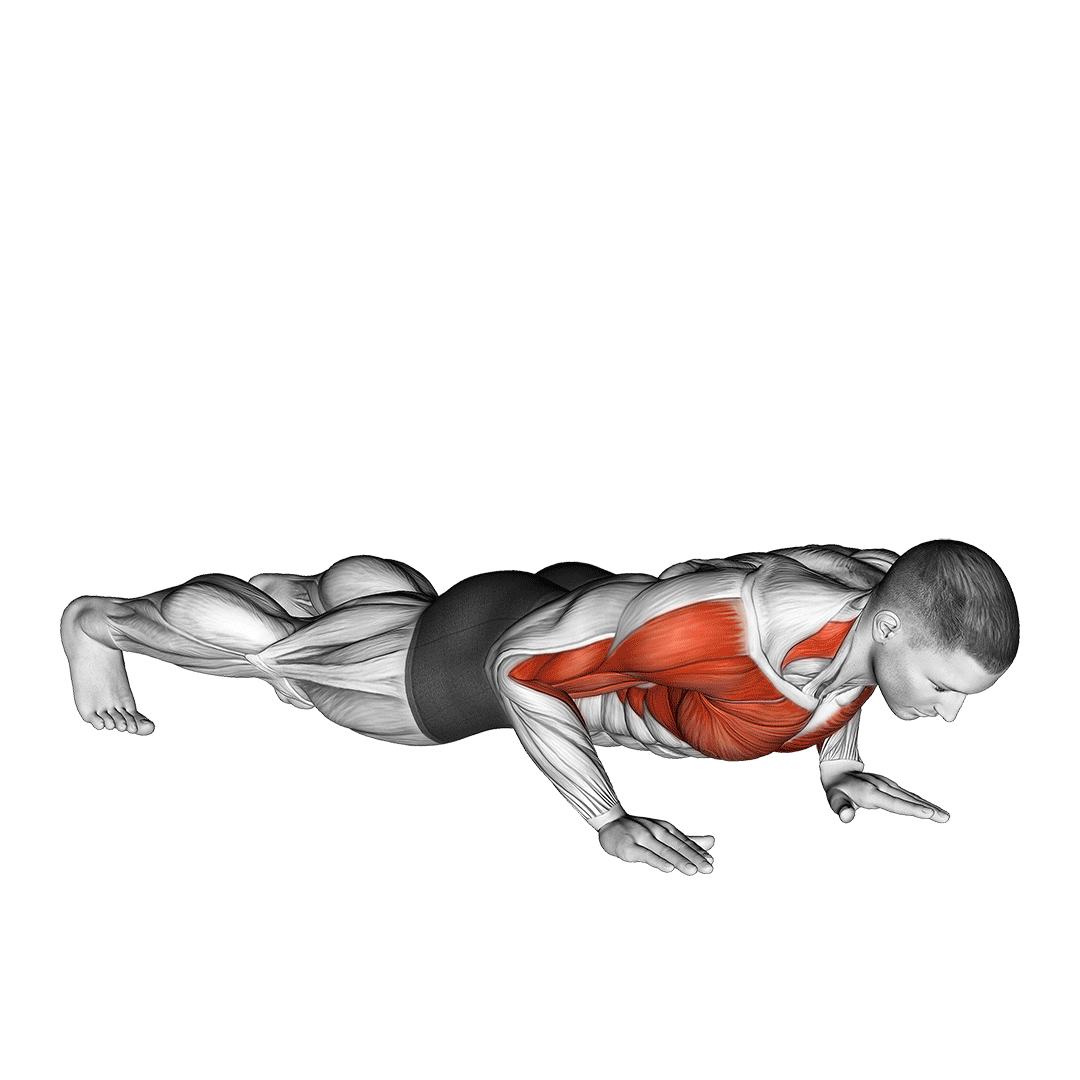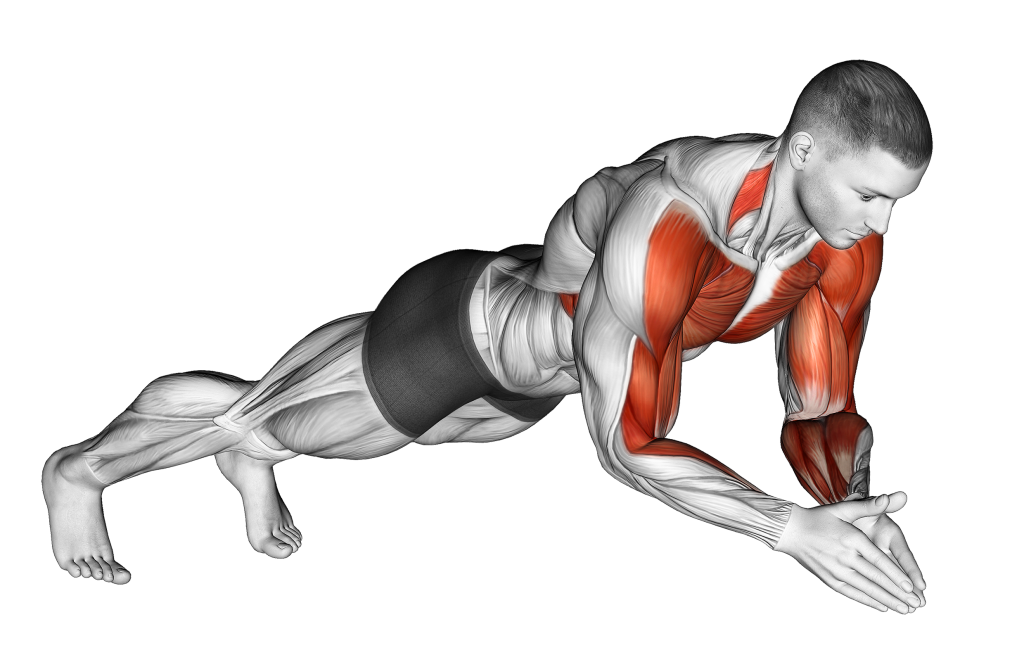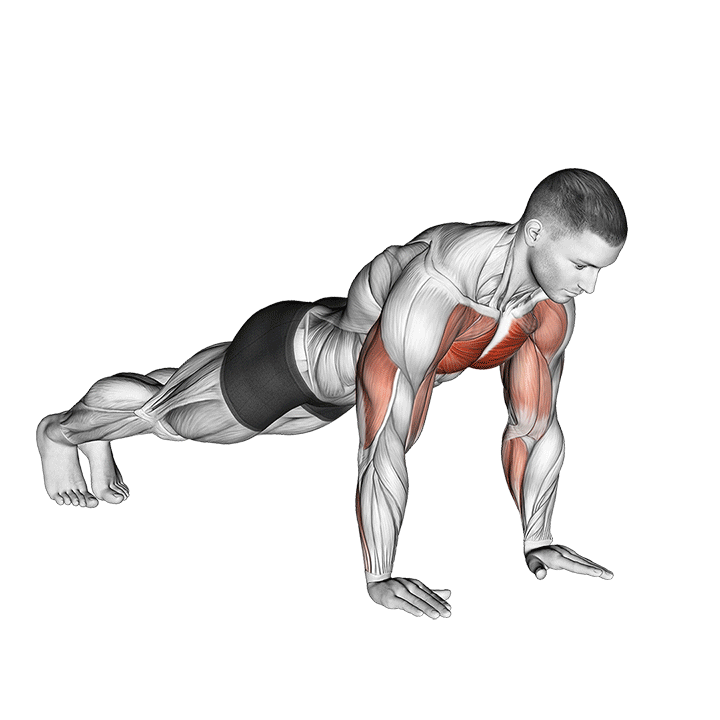Clapping Push Up: Benefits, Muscles Worked, and More
While the conventional push-up is considered standard fare in the realm of bodyweight exercise, its far flashier cousin takes things to greater heights through sheer intensity and power.
The clap push-up is an advanced calisthenic move that combines upper body explosiveness with complex technique to produce an exercise perfect for athletes and lifters alike.
Though it’s somewhat more technical than it sounds, clapping push-ups are simply conventional push-ups with the ascending phase of the movement performed with enough force to launch the torso into the air, allowing the exerciser to clap their hands before ending the repetition.
What is the Clap Push-Up?
Much like other push-up variations, the clap push-up is a multi-joint compound exercise traditionally performed with only bodyweight as a source of resistance. It serves a multitude of purposes, and can be found in anything from athletic training programs to bodybuilding splits.
Technically classified as a plyometric or ballistic exercise, clap push-ups have recently gained popularity owing to their effectiveness as a training tool, as well as how impressive they appear to be.

Due to the intensity of each repetition however, the clap push-up is not performed to anywhere near the same amount of volume as the traditional push-up, and may even be incompatible with certain programs or training goals.
As a side note, the clap push-up is also referred to as a clapping “plyo” push-up, of which is simply a variation of the standard plyometric push-up.
Who Should Do Clapping Push-Ups?
Clapping push-ups are an intermediate level exercise, and as such are more geared towards calisthenic athletes or exercisers with some level of experience already under their belt.
Novices or individuals unused to explosive bodyweight exercises may wish to perform traditional push-ups as an alternative instead.
In particular, athletes will see the greatest benefit from clapping push-ups, as it produces a training stimulus that is especially useful to individuals training for competitive sport.
How to do Clapping Push-Ups
To perform a repetition of clapping push-ups, the exerciser will enter a plank stance on the floor with their palms and feet touching the ground, core contracted and hands set wider than shoulder-width apart.
Bending at the elbows, the exerciser will then lower their chest towards the floor, stopping just shy of touching it. Pausing in this position for a moment, the exerciser will then continue by rapidly pushing their palms against the ground, launching their torso off the floor and into the air.

As the palms leave the floor, the exerciser will follow the momentum by clapping their hands together, before rapidly returning the hands to the floor and catching themselves in the original plank position.
This completes the repetition.

Combining these movements:
What Muscles are Worked by Clap Push-Ups?
As a compound exercise, clap push-ups train more than just a single muscle group - they work nearly every muscle found in the upper body, though not all to the same extent.
The muscles worked in a dynamic manner to the greatest capacity are called the “primary mover” muscles, with other muscle groups worked to a lesser extent being dubbed “secondary mover” muscles.
Likewise, muscles contracted solely in an isometric capacity are referred to as stabilizers.
Primary Mover Muscles
The main muscles worked by clap push-ups are the pectorals, the anterior deltoid head and the triceps brachii - all of which are used to a highly intense and dynamic level.
In particular, the clapping motion involved in the exercise allows the pectorals to be used very effectively, rivaling the recruitment seen in dips or deficit push-ups.
Secondary Mover Muscles and Stabilizers
Other muscle groups that are recruited to a lesser intensity or for only a portion of the range of motion are the serratus anterior and medial deltoid head.
For stabilizers, it is the abdominal muscles, forearms and glutes that are recruited in an isometric manner.
What are the Benefits of Doing Clapping Push-Ups?
Apart from the muscle-growing and strength-building effects that are characteristic of all resistance exercises, clapping push-ups are also capable of imparting certain benefits that are difficult to replicate with any other exercise, making them somewhat unique in the following aspects.
Upper Body Explosiveness and Power
It stands as no surprise that regularly practicing a movement can make an individual better at performing said movement - especially if it is one as wide-reaching as a push-up.
As such, regularly performing the clapping push-up will build impressive explosiveness and power in the upper body, both as a result of hypertrophic growth as well as from the exerciser learning to better utilize the force created by their muscles.
Carryover to Other Pressing Movements
The clapping push-up primarily targets fast-twitch muscle fibers, of which are rarely worked by other resistance exercises due to the slow and controlled manner in which they are executed.
Poor fast-twitch muscle fiber population can lead to powerlifters and other types of athletes becoming limited by the rate of force output that their muscles are capable of.
Fortunately, the clapping push-up is excellent at producing muscular growth that carries over to exercises like the bench press or weighted dip - meaning that regularly doing the clap push-up will improve the lifter’s performance in nearly all other pushing exercises.
Perfect Exercise for Athletes
Athleticism and other forms of real-world exercise involve sudden and intense bursts of power - be it breaking into a sprint, hoisting an object from the floor or tackling another player, muscular explosiveness is a necessity for athletes.
Keeping this in mind, it should be easy to see why the clapping push-up has cemented itself as a classic exercise among athletic training programs, as it builds not only muscular size and strength but also the necessary adaptations for improving an athlete’s physical explosiveness.
Conditions Body to Dynamic Movements
Not all individuals are adapted to the same physical stimuli - sedentary individuals or those of a more advanced age may find that high-impact exercises can cause more soreness and discomfort than their active counterparts experience.
This is (among other things) a result of the body being unadapted to high-impact dynamic exercises like the clapping push-up.
As such, while it is not recommended for novice exercisers to perform clapping push-ups, it is nonetheless an excellent way of reinforcing the joints of the upper body against the wear and tear of intense exercise.
Most Common Mistakes of Clap Push-Ups
Though the clap push-up is almost identical to conventional push-ups, there are nonetheless several common mistakes that even advanced calisthenic athletes can occasionally make - all of which should be corrected for a safer and more effective exercise.
Failing to Engage the Core and Glutes
Just as is the case in all push-up variations, failing to properly contract the core or glutes can lead to instability in the exerciser’s stance, if not other failures in form adherence. The glutes and core are both utilized as stabilizing muscles throughout the movement pattern of clap push-ups, and help prevent injuries or a failure in form adherence.
Being unable to properly recruit the core or glutes could be a sign that the push-up’s stance is incomplete, or simply that additional practice is needed to reinforce the mind-muscle connection.
Allowing the Lower Body to Rise With the Torso
Despite the explosive upward movement of the clapping push-up, it is important to ensure that the lower body remains relatively in-place throughout each repetition.
Allowing the hips (or even the legs) to rise alongside the torso can cause a loss of balance, as well as negate much of the resistance of the exercise, thereby reducing its effectiveness.
For the safest and most beneficial clap push-up, exercisers should strive to keep the lower body stable by contracting the glutes and firmly setting the feet on the floor.
Extending the Wrists and Fingers at Lift-Off
As tempting as it may be to give yourself an extra boost with your hands, doing so can potentially injure the many small tissues in the fingers and wrists, and should be avoided as much as possible.
From the starting stance of the exercise to the point of lift-off, the hands should remain splayed and flat against the ground, acting solely as a stable base with which the body can translate force through.
If you wish to perform push-ups in a way that helps target the forearms, fingertip or wrist push-ups may be used instead.
Hands are not Parallel With the Shoulders
More of a general push-up error than one specifically seen with clapping push-ups, setting the hands too far forward or too far back in relation to the shoulders can cause excess strain to be placed on the joints of the arms, as well as alter the focus of the exercise.
For the ideal clapping push-up stance, set the hands parallel to the shoulders along a lateral axis - meaning that a line may be traced from the palms to the shoulders from the side.
Setting the hands lower than this line can cause the triceps to be recruited to an unnecessary degree, whereas setting them too high can make the exercise more difficult than it needs to be.
Variations of the Clap Push-Up
The majority of clapping push-up variations are simply stance alterations that make the movement easier or harder, allowing novice lifters to perform a “lite” version of the exercise, as well as letting more advanced athletes continue the progression of their training through more challenging variations.
1. Deficit Clapping Push-Up
The deficit clap push-up is one among the most challenging variations of the push-up, placing significantly greater focus on the chest and its capacity to output a high amount of force in a very short frame of time.
Deficit clapping push-ups are simply clapping push-ups performed with the hands elevated higher than the ground, allowing for a wider range of motion and greater focus on the muscles of the pectorals.
2. Clapping Knee-Ups
For novice or intermediate exercisers who wish to retain the benefits of clapping push-ups but are unable to perform them to significant volume, clapping knee-ups are the perfect solution.
To substitute, all that is needed is for the exerciser to perform the exercise on their knees, rather than in a plank position. This reduces the amount of the body’s weight that is being lifted, and effectively halves the difficulty of what is otherwise an advanced calisthenic movement.
3. Decline Clapping Push-Ups
Just as conventional decline push-ups are used as a way of squeezing out more intensity from the standard push-up, so too is the decline clapping push-up a progression step from regular clapping push-ups.
To perform decline clapping push-ups, the exerciser will simply perform the exercise as normal - though with their feet elevated over the torso, increasing the amount of weight that is placed on the muscles of the upper body.
Frequently Asked Questions (FAQ)
What do Clapping Push-Ups do?
Clapping push-ups build power and explosiveness in the upper body, as well as help grow muscles like the pectorals, triceps and deltoids.
They are a particular favorite among competitive athletes and functional fitness enthusiasts, and are often combined with other ballistic exercises like the kipping pull-up, power clean and deadlift.
Are Clapping Push-Ups Harder?
Yes - clapping push-ups are significantly more difficult than regular push-ups.
They require greater coordination, muscular power and push-up mastery to perform correctly, and it is important for exercisers to first master the conventional push-up before attempting to do clap push-ups.
What are Clapping Push-Ups Called?
Clapping push-ups are occasionally referred to as plyo or plyometric push-ups - but this designation is technically incorrect, as regular plyometric push-ups do not involve a clapping motion and instead only require the exerciser to launch themselves into the air.
Here is a plyometric push up:

As such, a more accurate name would be “clapping plyometric” push-ups.
Final Thoughts
Due to the explosive and high-impact nature of clapping push-ups, make sure to perform them on a soft and non-slip surface - and, as always, ensure that proper form is followed at all times, especially for ballistic movements like the clap push-up.
References
1. Moore LH, Tankovich MJ, Riemann BL, Davies GJ. Kinematic Analysis of Four Plyometric Push-Up Variations. Int J Exerc Sci. 2012 Oct 15;5(4):334-343. PMID: 27182390; PMCID: PMC4738879.
2. Vossen J, Kramer JF, Burke DG, Vossen DP. Comparison of dynamic push-up training and plyometric push-up training on upper-body power and strength. J Strength Cond Res. 2000;14:248–253.

